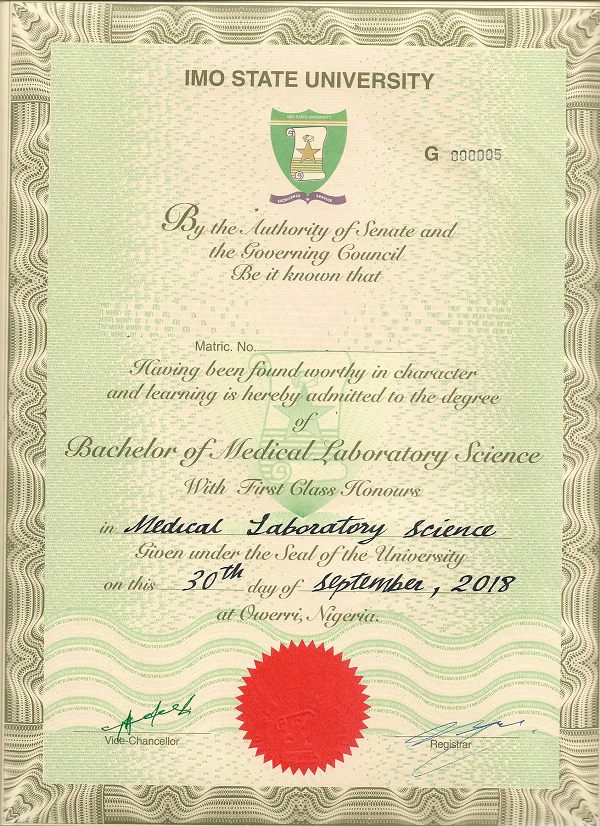Education Accountancy
Challenges Of Using Instructional Materials In Teaching Social Studies In Junior Secondary Schools In Aniocha South Local Government Area Of Delta State
Published
4 years agoon
Abstract
This study was carried out to investigate challenges of using instructional materials in teaching social studies in junior secondary schools in Aniocha South Local Government Area of Delta State. The study adopted a descriptive survey research design. The population of the study will comprise of the forty-three (43) social studies teachers in the twenty (20) secondary schools in Aniocha South Local Government Area of Delta State. However, there was no sampling because the population was manageable. Three research questions were raised to guide the study. The instrument used for data collection was a structured questionnaire which was developed by the researcher and validated by two experts; one in Measurement and Evaluation and one in Accounting Education Department of Federal College of Education (Technical) Asaba. Forty-three (43) copies of the validated questionnaires were administered to the teachers in Aniocha South Local Government and 38 questionnaires were retrieved analyzed. Based on the analysis, it was found among others that Unavailability of instructional materials for teaching social studies affects the use of instructional materials in teaching the subject. On the basis of the findings, it was recommended that more classrooms should be built to overcome the problem of overpopulated classrooms for effective teaching of social studies.
CHAPTER ONE
INTRODUCTION
Background to the Study
In modern teaching-learning situations, the utilization of instructional materials have become prominent because several experts and scholars are of the view that teaching will be better done if teaching aids or audio-visual aids are used and still, students learn better if they are exposed to use the teaching materials no matter how prototype it would be. The provision of instructional materials is supposed to cut across the four sensory organs viz-a-viz sight, hearing, touch and feeling. The proven contribution of teaching aids to the education process and the availability of some many education processes and the availability some many different instructional materials offer to teachers an opportunity to enrich and improve their teaching.
Every instructional material used for teaching is an aid. Such aids like chalkboard, books, chart, newspapers, modern pictures, radio, tape recorder, posters are good examples for teaching social studies. Learning could also be made pleasurable, if there are textbooks and other materials in the library so that students can, after guided and perhaps group or individual instructions be asked to practice on their own. Olutola (2014) opined that the idea of excellence in any school depend on the goal set for itself but goals set in turn depends on what the teachers are capable of accomplishing in the teaching-learning process that show permanent change in the behavior of the students.
Teaching at any level requires that the students be exposed to some form of simulation. Adekunle (2015) noted that teaching resources in social studies means anything that can assist the teacher in promoting teaching and learning. When the students are given the chance to learn through more senses than one, they can learn faster and easier. The use of instructional materials provides the teacher with interesting and compelling platforms for conveying information since they motivate learners to learn more. Furthermore, the teacher is assisted in overcoming physical difficulties that could have hindered his effective presentation of a given topic. Larson (2014) who noted that the use of electronically mediated instruction to duplicate the traditional face to face classroom has resulted in a shift from teacher- to student-centred classes. In this situation, the responsibility for learning is shifted to the students. The teacher facilitates the learning by acting as a coach, resource guide and companion in learning. The use of instructional materials does not only encourage teachers and students to work collaboratively but also results in more cooperative learning activities among the students.
Ikerionwu (2016) refers to instructional materials as objects or devices which help the teacher to make learning meaningful to the learners. Similarly, Ezegbe (2014) classified them into two as visual materials, made up of reading and non-reading materials and audiovisual materials comprising electrically operated and non-electrically operated materials. Social studies is a subject that depends on the use of a number of resources. Osakwe (2014) summarized these resources as textual like books, audio-visual and human resources. They stated that these resources are either used individually or collectively in any meaningful social studies teaching and learning situation.
The purpose of instructional materials is to promote efficiency of education by improving the quality of teaching and learning. According to Aduwa-Ogiegbaen and Imogie (2014) these materials and resources including audio tape recorders, video tape recorders, slide projectors, opaque projectors, overhead projectors, still pictures, programmed instruction, filmstrips, maps, chart, graphs and many more offer a variety of learning experiences individually or in combination to meet different teaching and learning experiences.
Heinecke (2014) observed that while some educators are fascinated by the potential of instructional materials in enhancing teaching and learning, other teachers lagged behind in using instructional materials to teach. However, achieving these laudable goals of conscientious utilization of instructional materials and resources in social studies teaching and learning has been very challenging in developing countries such as Nigeria. As noted by Garba (2016), the Nigerian teacher operates from a deficient environment where teaching and learning is seriously impoverished particularly in the rural set up. And even in the urban areas only few schools are connected to the national grid while virtually all the rural schools do not enjoy basic facilities like pipe borne water and electricity.
Since the inception of the National Junior Secondary School Social Studies Curriculum in Nigeria, few studies have been devoted to evaluating the availability and utilization of instructional materials and resources in the teaching of social studies in the Junior Secondary Schools. At the threshold of the new millennium, social studies teachers face both old and new challenges and need to evolve strategies to engage learners in activities that are active, meaningful and challenging.
Teachers are faced with divers challenges in the use of instructional materials in teaching social studies, particularly at the junior secondary school level such as the unavailability of instructional materials, overpopulated classroom and teachers’ attitude towards the use of instructional materials. According to Justin (2015), instructional materials for teaching social studies are in short supply which has affected the teaching and learning of the subject. Some of the materials needed to teach social studies are not available while some are outdated which make teachers not to be interested in using instructional materials because of the stress one has to go through just to get instructional materials. Classrooms, especially at the junior secondary school level (Public schools in particular) are overpopulated which affect the use of instructional materials in teaching social studies. Justin (2015) opined that classroom environment affect the use of instructional materials. The teachers find it difficult to use instructional materials in overpopulated classrooms because of the noise from students and the time spent in explaining certain concepts using instructional materials which has made many teachers to see the use of instructional materials as a waste of time.
Statement of the Problem
The place of instructional materials in teaching and learning cannot be over-emphasized. Instructional materials serve as vital tool for effective teaching and learning. However, it has been observed that teachers find it difficult to use instructional materials in teaching social studies in junior secondary schools which may be attributed to the unavailability of instructional materials, size of the classroom and teachers attitude. According to Yusuf (2017), the use of instructional materials can only be effective when the environment is conducive for learning. This shows that many factors are responsible for the challenges of using instructional materials in teaching social studies at the junior secondary school level. It is against this backdrop that this study is carried out to find out challenges of using instructional materials in teaching social studies in junior secondary schools in Aniocha South Local Government Area of Delta State.
Purpose of the Study
The main purpose of this study is to find out challenges of using instructional materials in teaching social studies in junior secondary schools in Aniocha South Local Government Area of Delta State. Specifically, the study sought:
- The extent to which unavailability of instructional materials affect the teaching of social studies in the junior secondary schools in Aniocha South Local Government Area of Delta State.
- The extent to which overpopulated classrooms affects the use instructional materials in the teaching of social studies in junior secondary schools in Aniocha South Local Government Area of Delta State.
- The extent to which teachers’ attitude affect the use of instructional materials in teaching social studies in junior secondary schools in Aniocha South Local Government Area of Delta State.
Research Question
To effectively carry out the study, the following research questions were raised:
- To what extent does unavailability of instructional materials affect the teaching of social studies in the junior secondary schools in Aniocha South Local Government Area of Delta State?
- To what extent does populated classrooms affect the use instructional materials in the teaching of social studies in junior secondary schools in Aniocha South Local Government Area of Delta State?
- To what extent does teachers’ attitude affect the use of instructional materials in teaching social studies in junior secondary schools in Aniocha South Local Government Area of Delta State?
Significance of the study
The study of this nature if implemented would be of benefit to teachers, students, ministry of education and the field of social studies. The findings and recommendations of this study would help the teachers to know the how their attitude affect the use of instructional materials in teaching social studies how the unavailability of instructional materials affect the use of instructional materials in teaching social studies in junior secondary schools which will help them to have a positive attitude towards the use of instructional materials in teaching social studies. It would also go a long way in helping the students to know how their attitude affect the use of instructional materials in teaching social studies at the junior secondary school level. Ministry of Education would benefit a great deal from this study because it would call its attention to the effect of unavailability of instructional materials on the use of instructional materials in teaching social studies at the junior secondary school level; the effect of populated classrooms on the use of instructional materials in teaching social studies and how teachers attitude affects the use of instructional materials in teaching social studies. The study would help them to as the matter of necessity build more classrooms in junior secondary schools to reduce the number of students in a class in order to encourage the use of instructional materials in teaching social studies. The study would be an addition to the literature in the field of social studies and also serve as a reference material for scholars and researchers who may wish to carry out a related study in this field.
Scope of the Study
This study was delimited to challenges of using instructional materials in teaching social studies in junior secondary schools in Aniocha South Local Government Area of Delta State. With particular emphasis on the unavailability of instructional materials, attitude of teachers towards the use of instructional materials and the challenges of using instructional materials in overcrowded classrooms.
Pages: 57
Category: Project
Format: Word & PDF
Chapters: 1-5
Source: Imsuinfo
Material contains Table of Content, Abstract and References.

You may like
Project Materials
IMSU Info contains over 1000 project material in various departments, kindly select your department below to uncover all the topics/materials therein.
Project Topic Search
- Accountancy 6
- Adult & Non-Formal Education 2
- Agric. Economics & Extension 7
- Anatomy 1
- Animal & Environmental Biology 10
- Architecture 2
- Arts & Design Technology 1
- Arts & Social Science Education 2
- Banking & Finance 6
- Biochemistry 8
- Biology 1
- Building 3
- Business Administration 6
- Business Education 17
- Business Law 1
- Chemistry/Industrial Chemistry 5
- Civil Engineering 3
- Computer Education 4
- Computer Science 5
- Curriculum and Instructional Technology 3
- Development Studies 2
- Economics 16
- Education 54
- Education Accountancy 49
- Education Administration 1
- Education Agriculture 13
- Education Biology 26
- Education Chemistry 2
- Education Economics 36
- Education English 11
- Education Government 16
- Education History 2
- Education Mathematics 10
- Education Physics 2
- Education Religion 1
- Educational Foundations 11
- Educational Psychology 1
- Electrical & Electronic Engineering 5
- English & Literary Studies 11
- Environmental & Applied Biology 2
- Environmental Science 5
- Environmental Technology 1
- Estate Management 7
- Fine and Applied Arts 2
- Food Science & Technology 9
- Foundations & Counselling 1
- French 1
- Gender & Development Studies 1
- Geography & Environmental Management 2
- Government & Public Administration 6
- Guidance & counseling 6
- History & International Studies 8
- Hospitality & Tourism Management 47
- Human Physiology 1
- Human Resource Management 1
- Industrial Technical Education 1
- Insurance & Actuarial Science 15
- Integrated Science 1
- Language Education 6
- Law 2
- Library & Information Science 31
- Life Science Education 9
- Linguistics and Igbo 2
- Management Studies 6
- Marketing 2
- Mass Communication 14
- Mechanical Engineering 3
- Medical Laboratory Science 18
- Microbiology & Industrial Microbiology 4
- Nursing Science 10
- Nutrition & Dietetics 27
- Office and Technology Management Education 12
- Optometry 10
- Physics/Industrial Physics 6
- Political Science 12
- Primary Education 38
- Project Management Technology 1
- Psychology 7
- Psychology & Counselling 2
- Public Administration 2
- Public Health 6
- Quantity Surveying 2
- Radiology 1
- Religious Studies 11
- Science & Vocational Education 1
- Science Education 10
- Social Science Education 36
- Sociology 13
- Sociology of Education 1
- Soil Science & Environment 3
- Statistics 1
- Surveying & Geoinformatics 2
- Theatre Arts 3
- Theology 1
- Urban & Regional Planning 7
- Veterinary 2
- Vocational and Technical Education 21
- Vocational Education 76
- Zoology 6

Is It Worth Registering a Pre-degree Program In IMSU? All you need to know about IMSU Pre-degree
7 Popular department in Imo State University (IMSU)

IMSU reprinting for 2023/2024 post UTME candidates has commenced

Steps on How to Apply for Certificate in Imo State University, Owerri (IMSU)

Is It Worth Registering a Pre-degree Program In IMSU? All you need to know about IMSU Pre-degree
7 Popular department in Imo State University (IMSU)

IMSU reprinting for 2023/2024 post UTME candidates has commenced

Steps on How to Apply for Certificate in Imo State University, Owerri (IMSU)

Is It Worth Registering a Pre-degree Program In IMSU? All you need to know about IMSU Pre-degree
7 Popular department in Imo State University (IMSU)

IMSU reprinting for 2023/2024 post UTME candidates has commenced

Steps on How to Apply for Certificate in Imo State University, Owerri (IMSU)
Trending
-

 IMSU News4 years ago
IMSU News4 years agoIs It Worth Registering a Pre-degree Program In IMSU? All you need to know about IMSU Pre-degree
-

 IMSU News5 years ago
IMSU News5 years ago7 Popular department in Imo State University (IMSU)
-

 IMSU News2 years ago
IMSU News2 years agoIMSU reprinting for 2023/2024 post UTME candidates has commenced
-

 IMSU News3 years ago
IMSU News3 years agoSteps on How to Apply for Certificate in Imo State University, Owerri (IMSU)
